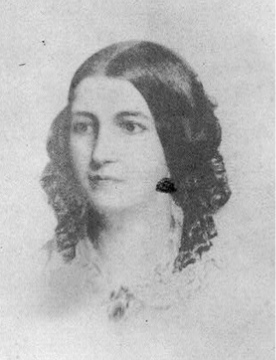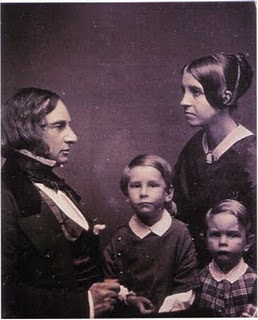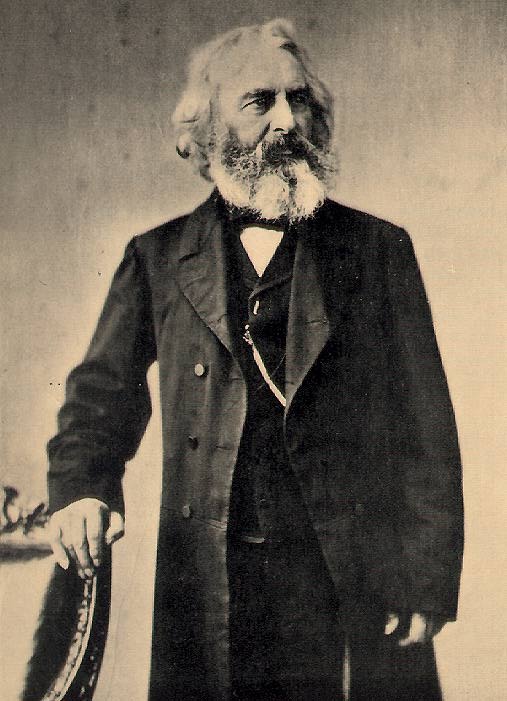Frances ‘Fanny’ Appleton (photo courtesy Library of Congress)'I Never Looked At Her Without a Thrill of Pleasure'
Henry Wadsworth Longfellow and The Tragic Death of His Beloved Wife Fanny
By Christoph Irmscher
Professor of English, Indiana University, Bloomington, and editor of John James Audubon: Writings and Drawings
On the afternoon of July 9, 1861, as the poet Henry Wadsworth Longfellow was asleep in his study, his wife Fanny came running in. She was engulfed in flames. Instantly awake, Longfellow grabbed a rug and wrapped it around her to extinguish the fire, injuring himself quite badly in the process. It was too late. Fanny's lower body and torso were so severely burned that she died the next day. In a matter of minutes, Longfellow's life was destroyed, too.
Henry Wadsworth Longfellow and wife
Frances ‘Fanny’ Appleton with sons
Charles and Ernest, ca. 1829 (Photo:
National Park Service, Longfellow
National Historic Site)There are different stories about what exactly caused this dreadful accident. The traditional version has Fanny sealing an envelope containing a lock of hair cut from one of her daughters when the candle she had used to melt the wax ignited her frilly summer dress. But Longfellow's daughter Annie, who was only five years old at the time, later admitted, privately, that she might have been responsible for what happened. She had been messing around with a box of matches, she said, when one of them suddenly dropped, flared, and set her mother's white muslin dress on fire. There is some evidence for the latter version. When Annie was born, her father, smitten with all things Italian, had given her the wonderfully resonant middle name "Allegra," the cheerful one. After the accident, Longfellow would refer to her as "Panzie," short for "Penserosa." Laughing Allegra (this is how readers knew her from Longfellow's "The Children's Hour") had become a sad, melancholy, pensive little girl.
No one was affected more by what had happened than Longfellow himself. As Fanny's body was still lying upstairs, Longfellow cowered down below, numb with grief, fearing he had lost his mind. Please, please do not send me to an asylum, he begged his friend Cornelius Felton, who had shown up to help, only to find that he really couldn't. The disaster that had befallen Longfellow was monumental. On July 13, they buried Fanny in Mount Auburn Cemetery, without Longfellow, who was too ill to leave the house. A day later, Fanny's father, Nathan Appleton, one of the richest men in Massachusetts, died too. "How I am alive after what my eyes have seen I know not," Longfellow eventually wrote to Fanny's sister Mary, struggling mightily to find words that would recreate his "beautiful" life with Fanny. "I never looked at her without a thrill of pleasure," he said, in one of the most moving declarations of married love I know in all of American literature. "She never came into a room where I was without my heart beating quicker, nor went out without my feeling that something of the light went with her."
Longfellow's grief knew no bounds, and it remained so for the rest of his life. He tried to be the best father he could to his five children, but something inside him had died, too. Frances Appleton had been brilliant, irreplaceably smart, and witty: a committed pacifist, a clever observer, a writer with a gift for nuances that rivaled that of any of her male contemporaries. Longfellow revered her. And he found himself helplessly drawn to her, looking forward to the "delicious" time he was able to spend with her alone, "in her chamber."
What her loss did to him is clear to anyone who so much as skims his still mostly unpublished journals, now kept at Harvard's Houghton Library. Longfellow's wedding day was the beginning of his "Vita Nuova of happiness," he claimed, a happiness that never gave way to familiarity, that never dulled his senses to the heartbreakingly beautiful sight of Fanny's face at night, in the lamplight, as she was bending over her book. Their anniversary, celebrated in his journal year after year after year, was, he said, his own personal "Easter."
Henry Wadsworth Longfellow: ‘Women have so much to suffer.’His deep love for her led him to recruit his dentist--since no physician seemed disposed to try it--to administer ether to his wife as she gave birth to their daughter, also named Fanny, on 7 April 1847, the first American woman to deliver a child under such circumstances. "No pain," Longfellow noted with satisfaction. "Women have so much to suffer. I told [Fanny] that she could congratulate herself upon having had it in her power to show her countrywomen how some of their agony might be safely avoided." I would be hard pressed to name another male American poet so attuned to the needs not only of his wife but of women in general.
How agonizing to him, then, to watch Fanny slip away from him so suddenly, so wretchedly, so needlessly. His own pain never subsided. He hid it from the world, especially from his children, performing the roles society and his ever-growing fame as a poet demanded of him, while inwardly he carried his grief, a grief that had grown to the size of a mountain, as he revealed in "The Cross of Snow," a poem he wrote a full eighteen years after Fanny's death and never published.
In the summer of 2006, I was preparing an exhibit for the Longfellow Bicentennial at Houghton Library. As I was sifting through the poet's papers, I came across a little envelope that had, in Longfellow's own handwriting, the year 1862 inscribed on it. Imagine my distress when I opened it and found tucked away inside it, tenderly wrapped, a beautiful curl of hair, light brown, mixed with some strands of white. The date (the correct one) written shakily on the wrapping-10 July 1861-left no doubt whose lock I had found in there. Someone had taken it from Fanny's head the day she died. Outside, the waning sunlight danced on the leaves of the crabapple trees in Harvard Yard. For a moment, time stopped.
Professor Irmscher's blog is posted, along with a host of other blogs of a literary nature, at the Library of America's Readers Almanac site. The Library of America , a nonprofit publisher, is dedicated to publishing, and keeping in print, authoritative editions of America's best and most significant writing.
***
The Cross of Snow
by Henry Wadsworth Longfellow
In the long, sleepless watches of the night,
A gentle face--the face of one long dead--
Looks at me from the wall, where round its head
The night-lamp casts a halo of pale light.
Here in this room she died, and soul more white
Never through martyrdom of fire was led
To its repose; nor can in books be read
The legend of a life more benedight.
There is a mountain in the distant West
That, sun-defying, in its deep ravines
Displays a cross of snow upon its side.
Such is the cross I wear upon my breast
These eighteen years, through all the changing scenes
And seasons, changeless since the day she died.
***
Despite the persistent pain and sadness he carried with him over losing Fanny and almost losing his son Charles, a Union soldier, who was wounded in November 1863 during the New Hope Church campaign in Virginia, Longfellow took heart in Charles’s survival and in December 1863 penned the stanzas, titled “Christmas Bells,” that were later set to music and became one of America’s most beloved Christmas carols, “I Heard the Bells On Christmas Day.” See the December 2010 issue of TheBluegrassSpecial.com for the story behind the story of the real-life events informing Longfellow’s contribution to the Yuletide canon.
Founder/Publisher/Editor: David McGee
Contributing Editors: Billy Altman, Laura Fissinger, Christopher Hill, Derk Richardson
Logo Design: John Mendelsohn (www.johnmendelsohn.com)
Website Design: Kieran McGee (www.kieranmcgee.com)
Staff Photographers: Audrey Harrod (Louisville, KY; www.flickr.com/audreyharrod), Alicia Zappier (New York)
E-mail: thebluegrassspecial@gmail.com
Mailing Address: David McGee, 201 W. 85 St.—5B, New York, NY 10024







